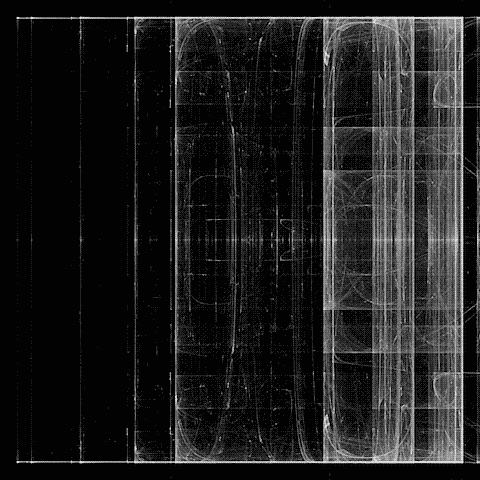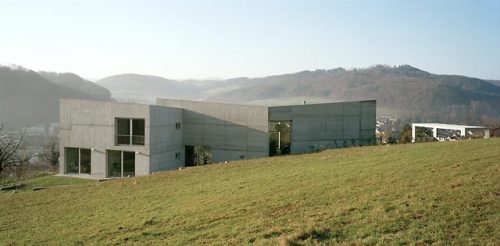Wednesday, April 17, 2019
crossconnectmag: anoptic’s inscrutable machines anoptic creates...








anoptic’s inscrutable machines
anoptic creates geometric gifs that are beautiful but at the same time feel old fashioned, like something Tesla would have created if he had a computer in 1900. While anoptic prefers to remain anonymous, he or she did make an interesting comment about animated gifs: “The art of the gif is in the loop. The single idea repeated over and over - both unending and unchanging at the same time. A glimpse at processes normally invisible, like peering into the workings of the inscrutable machine. Done well, it’s mesmerizing.” Exactly.
More unique art on Cross Connect Magazine:
Twitter || Facebook || Instagram
Posted by David
crossconnectmag: anoptic’s inscrutable machines anoptic creates... crss








crssanoptic’s inscrutable machines
anoptic creates geometric gifs that are beautiful but at the same time feel old fashioned, like something Tesla would have created if he had a computer in 1900. While anoptic prefers to remain anonymous, he or she did make an interesting comment about animated gifs: “The art of the gif is in the loop. The single idea repeated over and over - both unending and unchanging at the same time. A glimpse at processes normally invisible, like peering into the workings of the inscrutable machine. Done well, it’s mesmerizing.” Exactly.
More unique art on Cross Connect Magazine:
Twitter || Facebook || Instagram
Posted by David
Caramel Stuffed Chocolate Blossoms
Chocolate and Caramel are one of my favorite flavor combinations. I recently discovered caramel filled Hershey's kisses, and I knew I wanted to use them in a recipe! Thus, these Caramel Stuffed Chocolate Blossoms were born! They are chocolaty, sugary, and filled with caramel. What's not to love!? Make a batch with me!
Most blossoms are made with a peanut butter base, which I love~! But, not everyone is a fan of peanut butter. I wanted to create a blossom recipe with a chocolate cookie base.
The secret to making this recipe extra delicious is to make sure the cookies do not over bake. Chocolate cookies are hard to tell if they are done or not because you can't look for the golden edges. My rule of thumb is, if you can smell them from the oven, they are probably done! Remember, the cookies will continue cooking for an extra 5 minutes after you take them out of the oven.
These cookies call for the Caramel Filled Hershey's Kisses. I found mine at Dick's Marketplace. If you can't find the caramel kisses, you could use regular kisses, or even Rolo's!
Caramel Stuffed Chocolate Blossoms
Yields 3 dozen
3/4 cup unsalted butter
3/4 cup granulated sugar
1 egg
1 teaspoon vanilla
1/2 teaspoon salt
1 1/2 teaspoon baking powder
2 ounces milk chocolate, melted
2 cups flour
1/4 cup granulated sugar, set aside
36 caramel filled chocolate kisses (unwrapped)
Preheat oven to 350.
In a stand mixer, cream together the butter and sugar.
Add in the egg and vanilla and beat on medium speed until smooth.
Next, add the salt, baking powder, and melted chocolate.
Finally, add the flour, one cup at a time on a low speed, until dough forms. Chill dough in the fridge for 10-15 minutes to allow melted chocolate to set.
Roll dough into 1 inch balls and then roll in the granulated sugar, coated all sides. Place dough onto a greased or lined baking sheet. Bake for 10 minutes.
When cookies are finished baking, remove from oven and immediately press one caramel filled chocolate kiss into the center. Allow cookies to cool completely before serving.
redlipstickresurrected:Gianni de Conno (Italian, 1957-2017, b....

Gianni de Conno (Italian, 1957-2017, b. Milan, Italy) - Illustrations for Poesie Alla Luna aka Poems to the Moon, published 2009 by Edelvives. Mixed Media

Gianni de Conno (Italian, 1957-2017, b. Milan, Italy) - Illustrations for Poesie Alla Luna aka Poems to the Moon, published 2009 by Edelvives. Mixed Media

Gianni de Conno (Italian, 1957-2017, b. Milan, Italy) - Illustrations for Poesie Alla Luna aka Poems to the Moon, published 2009 by Edelvives. Mixed Media

Gianni de Conno (Italian, 1957-2017, b. Milan, Italy) - Illustrations for Poesie Alla Luna aka Poems to the Moon, published 2009 by Edelvives. Mixed Media

Gianni de Conno (Italian, 1957-2017, b. Milan, Italy) - Illustrations for Poesie Alla Luna aka Poems to the Moon, published 2009 by Edelvives. Mixed Media

Gianni de Conno (Italian, 1957-2017, b. Milan, Italy) - Illustrations for Poesie Alla Luna aka Poems to the Moon, published 2009 by Edelvives. Mixed Media

Gianni de Conno (Italian, 1957-2017, b. Milan, Italy) - Illustrations for Poesie Alla Luna aka Poems to the Moon, published 2009 by Edelvives. Mixed Media

Gianni de Conno (Italian, 1957-2017, b. Milan, Italy) - Illustrations for Poesie Alla Luna aka Poems to the Moon, published 2009 by Edelvives. Mixed Media
Gianni de Conno (Italian, 1957-2017, b. Milan, Italy) - Illustrations for Poesie Alla Luna aka Poems to the Moon, Published 2009 by Edelvives. Mixed Media Tapirulan
Studying Preindustrial Societies Informs us About How to Be Healthy. Podcast with Herman Pontzer

 We humans have not been around long. The first of our kind emerged roughly two million years ago, but our species (Homo sapiens) only appeared about 300,000 years ago. For the vast majority of human history, we lived hunter-gatherer lifestyles, hunting wild game and gathering wild plants for subsistence.
We humans have not been around long. The first of our kind emerged roughly two million years ago, but our species (Homo sapiens) only appeared about 300,000 years ago. For the vast majority of human history, we lived hunter-gatherer lifestyles, hunting wild game and gathering wild plants for subsistence.
But then humans underwent a series of revolutions that upended people’s lives so dramatically that some hunter-gatherers would now be hard pressed to identify individuals living in postindustrial societies as people of the same species. These revolutions occurred in the blink of an evolutionary eye, and the discordance between our comparatively ancient genomes and our modern lifestyles is thought to underlie numerous so-called “diseases of civilization”, such as diabetes and obesity.
With this in mind, we can learn much about how humans probably once lived by studying preindustrial societies. In a previous episode of humanOS Radio, for example, Dan spoke with Jerry Siegel about what Jerry found about natural patterns of sleep by tracking this behavior in three groups of preindustrial people.
These types of studies aren’t just a way of satisfying a curiosity about what once typified humans though, for research on preindustrial societies has consistently shown that these people have exemplary health. And when we consider that modern humans are succumbing to chronic diseases at an alarming rate, we clearly have much to learn from preindustrial societies. This brings us to the latest episode of humanOS Radio.
Guest
Joining me for this episode is Herman Pontzer, Associate Professor of Evolutionary Anthropology at Duke University. Herman’s research focuses the physiology of humans and apes, and he aims to understand how ecology, lifestyle, diet, and evolutionary history affect metabolism and health. His work also explores how ecology and evolution have influenced physical activity and the musculoskeletal system.
Herman has done some fascinating studies of small-scale societies including hunter-gatherers and subsistence farmers, and he’s the first person I’ve interviewed who has a first-author paper in the journal Nature to his name… which is kind of a big deal in the world of scientific research.
Herman has contributed to numerous studies exploring the biology and behavior of preindustrial societies, including Jerry Siegel’s work on sleep that I mentioned. However, Herman is perhaps best known for his constrained energy expenditure hypothesis.
The basic premise of this hypothesis is that organisms evolved in conditions of limited resources, such as food. In response to this, living beings evolved mechanisms to maintain total energy expenditure (calories burned) within a range aligned with how much food was typically available in their environments. As a result, we animals compensate with biological and behavioral mechanisms to blunt changes in energy balance that would have resulted from shifts in physical activity levels and food intake.
To give just one example of this, this hypothesis proposes that if somebody increases his or her physical activity, he or she will not necessarily burn more calories in the long term. Instead, the energy available within the person’s body will be simply be allocated differently between essential processes and non-essential biological processes.
This hypothesis is very intriguing and can help explain why our modern lifestyles predispose us to various maladies. But rather than elaborating on it more here, you should tune in to the podcast by clicking on one of the links below!
In this podcast we explore many subjects, including:
- Herman’s constrained energy expenditure hypothesis:
- The concept of energy compensation
- Implications of the model for people trying to lose weight
- The importance of resistance exercise in the context of the model
- Energy allocation and the distinction between essential and non-essential functions
- The biological bases of changes in energy expended during physical activity
- What we can learn from studying preindustrial societies about how to be healthy:
- Dietary macronutrient composition
- Seasonal variation in diet

- Dietary energy density
- Physical activity in preindustrial societies
- Social life in preindustrial societies
- Whether preindustrial societies have changed in recent years
- The future of preindustrial societies
What can we learn from studying preindustrial societies about how to be healthy? Tune in to this podcast with @HermanPontzer for more!
Click To Tweet
Listen here
On Soundcloud, iTunes, Google Play, Stitcher, and YouTube
Support
Have you considered becoming a Pro member of humanOS.me? It costs just $9.99 per month, and when you go Pro, you get access to all our courses, tools, recipes, and workouts. Pro members also support our work on blogs and podcasts, so thanks!
Leave a review
If you think other people would benefit from listening to this show, you can help us spread the word by leaving a review at iTunes. Positive reviews really help raise the profile of our show.
Transcript
| Herman Pontzer: | 00:06 | What we find when we measure energy expenditure across different populations and different lifestyles, is that people who are very active burn the same number of calories every day as people who are not very active. And so, there doesn’t seem to be any relationship at all between how active a person is and how many calories they burn every day. |
| Kendall Kendrick: | humanOS. Learn, master, achieve. | |
| Greg Potter: | 00:21 | Welcome back to humanOS Radio. My name’s Greg Potter and I’m hosting the show today once again. Joining me for this episode is Herman Pontzer, Associate Professor of Evolutionary Anthropology at Duke University. |
| Professor Pontzer’s research focuses on the physiology of humans and apes and aims to understand how ecology, lifestyle, diet, and evolutionary history affect metabolism. His work also explores how ecology and evolution have influenced physical activity and the musculoskeletal system. Professor Pontzer has done some fascinating studies of small-scale societies including hunter-gatherers and subsistence farmers. | ||
| 00:33 | Herman, welcome to humanOS Radio. | |
| Herman Pontzer: | Thanks for having me on. Lovely to be here. | |
| Greg Potter: | I’m keen to get straight to your constrained total energy expenditure model. Can you briefly describe the main premises of energy constraints, mentioning its evolutionary basis and the concept of energy compensation? | |
| Herman Pontzer: | Yeah, Sure. So let’s start with what everybody learns in school or what we all assumed to be true, which is a straight forward way of thinking about how energy expenditure works. The way we are typically taught about how energy works. I say that because this is how I used to teach it myself and how I learned it coming up through school, is that the number of calories you burn every day is just a simple function of how big you are and how active you are. | |
| 01:10 | And so, you can’t change how big you are very easily, but you can change how active you are. So in the simple additive model, the more and more active you are, the more your calories per day go up, up, up. And so, if you’re more active, you burn more calories. If you’re less active, you burn fewer calories over the course of the day. It’s a very simple one-to-one relationship. | |
| What we’re finding, and this is something that we hadn’t expected, but this is borne from the data measuring energy expenditures in different populations and across different kinds of lifestyles, is that it doesn’t seem to work that way at all. | ||
| 01:12 | Instead, what we find when we measure energy expenditure across different populations and different lifestyles, is that people who are very active burn the same number of calories every day as people who are not very active. And so, there doesn’t seem to be any relationship at all between how active a person is and how many calories they burn every day. We call that a constrained total energy expenditure model. | |
| Let’s imagine that you are the laziest couch potato that one could imagine, and you go from that lifestyle to a more active lifestyle. You might see initially some increases in energy expenditure, but then very quickly what you’ll see is that the total number of calories that your body can burn will plateau. | ||
| 01:22 | And so, as you get more and more and more active, you won’t see any increases in the total calories that you burn every day, because instead, your body compensates for that extra energy expenditure that you spent on activity as you get more active, it’s compensated by spending less energy elsewhere. | |
| One thing we’ve known for a long time, over a century now, going back to the early days of physiological research in metabolism, our bodies expend almost two thirds of their energy every day on things that are not physical activity. Even active people expend most of their calories on things like immune function, keeping our tissues repaired and in shape, keeping our organs running. | ||
| What we think is happening is as you get more and more active, your body turns the energy expenditure on those activities down a bit. It makes room for more physical activities. So that the bottom line is that you don’t expend more calories everyday even as you get more and more active. | ||
| One thing I want to add to that, is that I’m not saying that if I run a marathon today and I don’t tomorrow, that the energy expenditures are the same. The adaptation doesn’t happen that quickly. Nor am I saying that if you start an exercise program tomorrow that you want to see some increases in energy expenditure for a while, while your body adjusts. | ||
| What I’m saying is we when look at habitual levels of physical activity, that’s where we see the lack of correspondence between activity and expenditure because after the body gets a chance to adjust, we see everything evening out. | ||
| Greg Potter: | I know one of the interesting ideas that you mentioned in one of your papers is that the range of energy compensation may correspond with the range of energy expenditure that typifies humans during our evolution. While we’re on the subject of energy compensation, what do you think about the idea that energy compensation may be lower in people who have lots of body fat? | |
| Herman Pontzer: | Yeah, well, so this raises the question of how does it work and why does it work the way it seems to work. And so, the evolutionary logic we think to why the body would compensate at all. Imagine a human or imagine any animal, because this happens in other species too, not just humans, imagine any organism in the wild where resources are limited. Energy compensation allows you to reduce the impact of increased activity, of how many calories you need every day. | |
| At the same time by burning more calories than you absolutely need to, as things get good, you can expend those extra calories during the plush times on things like reproductive effort and immune effort, things that might have gotten cut out when you were super active. | ||
| So we think that’s evolutionary logic. To apply that to the question of body fat. The signals that say, “Hey, things are stressful, energy is limited, perhaps we should compensate by turning other activities down.” That might be a weaker signal in someone who’s got more body fat because your body fat is basically a reserve fuel tank. And so, if you’ve got a lot of reserve fuel on board, you might be less responsive to these energy stress mediated responses. | ||
| Greg Potter: | Staying on the subject of adiposity, there’s a large variation between people and how they respond to changes in energy availability that results in an energy surplus or a deficit. So for example, when they suddenly increase their caloric intakes, some people gain lots of fat while others gain none. Do you have any thoughts on how energy availability might interact with physical activity, energy expenditure? | |
| Herman Pontzer: | Well, it’s tough. These are things that we’re still trying to figure out. We know that there’s individual variation of course, but people in general are quite good at matching their expenditure to their intake. Some really nice work by Leibel and Rosenbaum in the ’90s showed that you make people overeat their metabolic rates will actually go up in response to that increased intake. The effect is that burns off the extra intake. If you reduce people’s intake, their energy expenditures go down. So our bodies do a good job of matching our expenditure to our intake. | |
| 04:00 | Now when we see people who are increasing their food intake and they’re turning that into fat instead of just burning off the extra, that’s saying that for some reason in those folks it’s not quite as well matched. Why that would be how that works, these are questions we’re still trying to untangle. | |
| Greg Potter: | So your research implies that a person’s energy intake is the main driver for his or her body mass. Can you touch on what you think the most important implications of your model are for curbing overweight and obesity? | |
| Herman Pontzer: | 04:17 | Yeah, so I think our work adds to what people have been showing in studies going back decades, which is that if you want to manage your weight, the most effective way to do that is to manage calorie intake. If you try to manage weight by focusing on energy expenditure, even though, and I’ll just say this right off the bat, exercise is fantastic, and we all should do more of it. So we’re not saying anything about exercise being not great for you, it is. But if you focus on exercise as your primary way of managing weight, you’re going have less effective results because your energy expenditure is stuck. |
| That’s what the energy constrained model shows. That’s what the data shows that it’s really hard to budge someone’s energy expenditures, the body compensates so effectively. And so, it’s much easier to get people to overeat or to watch their diet and it try to be a negative energy balance for a while. So on a societal level, if you want to curb obesity, we should focus on diet and energy intake. | ||
| Greg Potter: | I’m going to play devil’s advocate for a second if that’s okay? | |
| Herman Pontzer: | Sure. Yeah. | |
| Greg Potter: | 05:22 | Given that many adults gain weight over time, during the holidays especially, I’ve always thought that resistance training that’s programmed to increase fat free mass is one of the best antidotes to avoiding unwanted fat gain. Basically, resistance training may help direct any surplus energy to fat free mass instead of fat mass, and your work and that of others shows that fat free mass is the main determinant of total energy expenditure. |
| So in this way, I suppose that unlike some forms of exercise, regular resistance training indeed affects total energy expenditure across longer periods. Do you have any thoughts on this in the context of your model? | ||
| Herman Pontzer: | 05:43 | Well, I don’t disagree. I think if you can keep your fat free mass up, that’s going to be basically the only sustainable way to keep your total energy expenditure up. But I think any exercise is good exercise. I’m not partisan to any particular kind. And so, I think you and I are actually on the same page. |
| I would say that I think the big metabolic affects you get in terms of tamping other physiological activity down, I think is one of the big benefits of exercise, things like reduced inflammation for example. My prediction is that you’ll get the biggest effect on those based purely on calorie workload. | ||
| However many calories you burn, that’s going to be your metric of how well you’re tamping down inflammation, for example. That’s my prediction. I don’t know if that’s true yet, but we’re trying to figure that out. If that’s true, then it won’t matter how you get your calories burned in exercise, but you’re going to want to make sure that your workload is sufficient to see those kinds of effects. | ||
| Greg Potter: | 06:24 | So you’ve touched on this a couple of times now. Can you speak about how physical activity might influence energy allocation, and just highlight the distinction between essential and nonessential processes? |
| Herman Pontzer: | Yeah, so this is one of the things we’re really excited about with this constrained model and the data that seem to suggest it. You look at people who are very active and people who are not, they’re burning the same number of calories. Well, physical activity never becomes free. In fact, if you look at people who are really trained and people who aren’t, their energy costs of walking and running for example, are about the same. | |
| 06:35 | So what’s happening as your body adjusts and compensates to keep total energy expenditure the same with more activity, isn’t that the activity is getting cheaper, it’s that you’re taking energy away from some other tasks. We could have a good think about what all those different tasks are, but when we look across the body, what we find is that we do see this reduction in basically everything we’ve looked at in terms of energy expenditure on different physiological tasks. | |
| So for example, if you look at the immune system, we see that people who exercise regularly have lower background levels of inflammation. Inflammation, it’s a bad thing, chronic inflammation. It’s a necessary response to infection, but high levels of immune function are bad for you, but chronic exercisers have lower levels of inflammation. | ||
| People who exercise all the time or are really physically active, have lower levels of reproductive hormones, for example. So testosterone is lower in men who exercise all the time. Estrogen is lower in women who exercise all the time. So the reproductive system is being turned down a bit as people exercise more and more. | ||
| 07:29 | Your stress response, looking at cortisol responses or your fight or flight response, that seems to get suppressed a bit in chronic exercisers, which sounds like a bad thing. But people who are exercising all the time, they have a lower stress response. | |
| And so, when we look at all this in sum, our bodies are cutting out the nonessential stuff. Inflammation is important sometimes, but you don’t want it up all the time, but you need some levels of reproductive hormones for reproduction to work, but you don’t need sky-high levels. | ||
| 07:32 | And so, what seems to be happening as people exercise regularly is it cuts out that nonessential stuff and makes us a lot healthier. Now you take it too far and eventually there’s no room to cut out anymore nonessential stuff, you need to start cutting into the essential stuff, and we actually do see that. | |
| So if you look at athletes who are training with enormous workloads, they often actually have health issues related to overtraining. We call it over-training syndrome. So women for example, will stop ovarian cycling, and men and women athletes at that elite level can have difficulties recovering from colds, and actually get more susceptible to colds, that kind of thing. We think that’s because you cut out all the nonessential stuff and you are asking to cut out even more. The only thing that’s left to cut out is stuff that actually you’d rather have. | ||
| Greg Potter: | 07:32 | You mentioned Rudy Leibel earlier, and obviously he’s famous for his work on leptin. When I was thinking about your work, the various theories that have been put forward to explain how our bodies regulate how fat we are, came to mind. One example of which is Kennedy’s lipostat model. Kennedy’s model for example, focused on certain structures, such as parts of the hypothalamus. |
| Do you have any thoughts on whether some corollary exists for energy invested in physical activity and which structures might be involved? Might it be that high levels of physical activity affect the energy cost of muscle contraction perhaps through effects on factors such as skeletal muscle, myosin heavy chain composition? | ||
| Herman Pontzer: | There’s a guy named Rollins who actually had this activity step model, to harken back to the ’90s and think about the historical background for this. Rollins idea was that I think like you’re suggesting that somehow the body wants to maintain a certain level of physical activity. He didn’t have a mechanism in mind, but presumably it would be a kind of neurological mechanism that would keep people at a certain level of physical activity. And so, for example, if you didn’t exercise maybe you’d fidget a bit more or do some other non-exercise-y activity just to keep yourself moving. | |
| 08:08 | There’s not a lot of great evidence for that, I have to say. That idea was taken up by a guy named Jim Levine, and if you’ve heard of this concept of NEAT, Non-Exercise Activity Thermogenesis, Jim Levine’s idea, picking up on Rollins idea, was that if people don’t exercise, they’ll do things like fidget and they can burn off those extra calories with their muscles some other way, and conversely if people start exercising then they’ll cut out that other stuff and keep activity at a certain level. | |
| Those ideas were generated in the late ’90s and early 2000s before we had good accelerometry measurements. Now that we’ve got really good measures from accelerometry, these little movement devices, the step counters in your smartphone and your Fitbit and that kind of thing, we’ve got a much better picture of just how physically active people are every day. | ||
| If you get people exercising, it turns out there’s not a lot of evidence that they cut out other stuff that they’re doing in terms of physical activity during the day. So the compensation might be partly due to changes in activity outside of exercise, but it doesn’t seem to be explain all of it, they seem to be really variable. | ||
| So that suggests that there’s no strong mechanisms that wants to keep your exercise levels constant, which is a long way of answering part of your question. What was the other bit about the myosin heavy chains? | ||
| Greg Potter: | 08:56 | Just the idea that myosin heavy chain composition might influence the energy costs of muscular work. So if for example you have high levels of activity, then that might cause a transition in some of those isoforms towards slower isoforms, and that might thereby reduce the cost of muscular work, which could potentially explain why the energy cost of physical activities is decreasing over time. |
| Herman Pontzer: | Yeah. Okay. Okay. You wouldn’t change how active you are, but you would change how much it costs. Again, there’s not a lot of great evidence for that. This could be very muscle specific. If you look at someone who’s a powerlifter versus someone who is an endurance athlete, you’re going to see your biggest potential for differences there, but I don’t know that anybody’s looked at that in an expansive way. | |
| 09:07 | But what I do know is that when we look at people who are really physically active, so I’ll give you an example of this. We work with hunter-gatherers in northern Tanzania, and these guys, the name of the population is the Hadza. There a traditional hunting and gathering population in Northern Tanzania. They’re extremely physically active. They get about as much physical activity in a day as most Americans get in a week. They walk miles and miles a day. | |
| Men typically hunt wild game. Women typically are going after a wild plant foods. They are the first population that we studied that suggested that this constrained energy model should be true. Even though they’re extraordinarily physically active, they burned the same number of calories every day as folks in the West? | ||
| Okay. Part of our work there was measuring the energy cost of walking for these guys. So we brought out a portable respirometry system that measured carbon dioxide production and oxygen consumption while you’re out walking. We cleared out a level track around their camp, these guys live in grass houses in the middle of the Savannah, cleared out a big walking track, me and Dave Raichlen, and Brian Wood, when we were out, we’re doing this work. | ||
| We measured the energy cost of walking, and what we found, even though these guys walk so much more than we do in the West, and even though they seem to clearly show this energy compensation, their energy costs of walking were the same as you and me. That actually fits with what we’ve seen with endurance training studies in other labs. People who train a lot to either walk or run more and more and more, their endurance goes up, they’re able to walk or run faster and longer, but they don’t really change the energy cost of walking or running per kilometer. | ||
| And so, are there going to be muscle changes in response to training? Absolutely. Will some of these affect economy? Probably. Is it a big enough affect that we can explain energy compensation that way? I don’t think so, and that’s because when we’ve tried to measure energy efficiencies of walking or running with the main physical activities of these groups are doing, we don’t see that they’re more economical at it. | ||
| Greg Potter: | Staying with preindustrial people. Your view of hunter-gatherers as models in public health is superb. I’m keen to bring to light some of the points that you make in it. So I’m going to ask you a series of short questions, if that sounds good? | |
| Herman Pontzer: | I’ll try to give short answers, but I can’t promise. I’m paid to be verbose. I’ve been rewarded for it, so I’ll do it what I can. | |
| Greg Potter: | Cool. There’s of course remarkable diversity between the diets of different preindustrial people, but do these people generally consume low carbohydrate diets? | |
| Herman Pontzer: | No. There’s an incredible amount of diversity, as you say. A lot of these groups eat more carbohydrates as a percentage of their total calories than Americans or Europeans. | |
| Greg Potter: | 11:28 | I know you mentioned that 16 to 20% of Hadza energy intake is from honey and bee larvae. |
| Herman Pontzer: | That’s right. | |
| Greg Potter: | Have you ever found that ketones are present in the urine of the Hadza? | |
| Herman Pontzer: | 12:04 | Never. We haven’t checked enough yet. We need to do more, but in the couple dozen that we’ve looked at, we haven’t ever seen the ketones, no. |
| Greg Potter: | Can you give us some idea of how much fiber preindustrial people consume? | |
| Herman Pontzer: | Ah, good question. I’m trying to remember that table from our paper, 100 grams a day. | |
| Greg Potter: | You say that as if you’re expecting me to correct you. Don’t worry, I won’t. That sounds about right, but it’s a lot of fiber. | |
| Herman Pontzer: | As I recall, US diet is about 20 grams of fiber a day, and so it’s something like five times more and I think that’s probably a good rule of thumb. | |
| Greg Potter: | Next question. Preindustrial people at higher latitudes tend to have lower intakes of plant foods than people near the Equator. Do you think that latitude is something we should consider when personalizing nutrition? | |
| Herman Pontzer: | 13:42 | No, not really. So you’re right, people who live at extremely high northern latitudes don’t eat many plants because surprise, surprise, not many plants grow at really high latitudes. However, if we were to unpack why we expect that that would have anything to do with how we ought to need today. The idea there would be that somehow people who live in the northern latitudes today are descendants of hunter-gatherer populations who live in northern climates recently that we have these ethnographic data for. |
| In most cases, that’s not true. So for example, my family a few generations ago lived in Germany, but the Western Europeans came from as far as we can tell, the Eurasian Steppe and farther south, and that’s only been a few thousand years. It’s hardly any time at all for evolution to have happened. The idea that somehow if you’re a Northern European that you’ve come from the Arctic, just doesn’t match at all with how we know in fact human population migration has gone. | ||
| Greg Potter: | 14:03 | I thought about this a little bit in the context of changes in light-dark cycles, and work by people like Ken Wright has shown that our circadian systems can quickly adjust to change in the photoperiod, meaning that melatonin synthesis, and hence the biological nighttime’s longer in the winter. Since melatonin seems to worsen oral glucose tolerance, to me, this implies that it makes sense to compress the caloric period in the winter, by which I primarily mean having an earlier dinner. But interesting to hear about diet quality too. |
| Next question. Hunter-gatherers are lean and generally in excellent metabolic health. One thing that I’ve always told people looking to lose fat is to generally favor micronutrient dense, but macronutrients sparse foods. How does the energy density of hunter-gatherer diets compare to ours, and do you think we should learn from any differences? | ||
| Herman Pontzer: | Yeah. Hunter-gatherers eat less energy dense foods than folks do in the West. It’s not a big difference, but it’s probably enough to matter. It’s probably about 10 to 20% fewer calories per gram. When you think about why they’re less energy dense, it’s because they’re higher in fiber. Again, I think eating lots of fiber will fill you up. You’ll eat less anyhow, and you’ll get more nutrients through eating nutrient dense foods. Of course, you could just eat cardboard, that won’t help you, but if you eat nutrient dense foods that are also high in fiber, I think that’s a win-win. | |
| Greg Potter: | Okay. Let’s pivot back to physical activity. People have written about how humans are uniquely adept at persistence hunting, but how much running do preindustrial people actually do? | |
| Herman Pontzer: | It depends on the people, but it’s not true that they all run. For example, the Hadza don’t run, the Tsimané in Bolivia don’t run. Even the Tarahumara, the folks from Chaco Canyon in Mexico, who famously run these enormously long races as part of their cultural traditions, they only run during those celebrations. They don’t seem to run outside of that. | |
| And so, it’s absolutely true that humans are impressive endurance animals compared to any of the other primates, even compared to most other mammals. It’s not true that we universally are all runners in terms of preindustrial human cultures. That’s what I have to say about that. | ||
| Greg Potter: | One thing that I found interesting in one of your papers, and please correct me if I’m wrong, but your data to show that the Hadza men walk about twice as far as the women, but have lower levels of moderate to vigorous intensity physical activity. | |
| Herman Pontzer: | 16:09 | Yeah. |
| Greg Potter: | What explains that? | |
| Herman Pontzer: | 16:21 | Well, the moderate vigorous physical activity is based on either accelerometry or heart rates, and the mileage of course, is based on GPS measurements. So that’s why they’re not one-to-one. But the reason that you could have such a big difference is that women do all sorts of work that doesn’t involve walking. So women are digging up wild tubers for hours a day. That’s a lot of heavy work. They are wrestling kids, doing all sorts of physical stuff. That doesn’t mean they’re covering ground and that’s the short answer, that’s why. |
| Greg Potter: | Next question. There’s some evidence that metrics such as cardiorespiratory fitness in some preindustrial people have changed across time. How much do you think that biology and behaviors of preindustrial people have changed in recent years? Does this affect their utility as models of how our ancestors lived? | |
| Herman Pontzer: | 16:28 | Yeah, that’s a great question. The short answer is, we don’t really know. It’s hard to know how different things have become for these populations because the methods available 100 years ago when these first measurements were being taken, aren’t the same methods that we have available now. |
| Two things. I’m sure that they’ve changed because all populations change all the time, and that gets to this point that none of the populations today or any of them in the past are the MODEL, that we should all be striving to emulate. All these populations are just examples of what it can be like to be a hunter-gatherer or be a subsistence farmer. Just like American culture has changed, so is theirs over decades or centuries, or thousands of years. | ||
| 16:38 | Now, does that affect their utility? I don’t think so, because the common elements that they’re holding onto that don’t change are these really high levels of physical activity, the wholefood, natural food diets. The fact that in terms of the public health value of this kind of work, even today we can go to a Hadza camp and we’d find they have excellent cardiometabolic health. | |
| Whatever the changes have happened over the last 10 years or 100 years, we should still wish that we had cardiometabolic health as good as they do. So I don’t think it changes the value of it, but I think what it says is, be careful about these romantic ideas about any one population is the population that we should all emulate. You’re wrong from the start if you go that way. | ||
| Greg Potter: | 16:48 | Other than physical activity, diet and sleep, which things about hunter-gatherers do you think the rest of us might learn from these people? |
| Herman Pontzer: | It’s notable that they live their lives outside. They are surrounded by friends and family their whole lives. There’s almost no inequality because nobody has anything. That’s not entirely true, they’ve got their possessions, but it’s not much. They’re not materialistic in the way that we seem to be in the West. | |
| 16:54 | I think we could learn from that. Try to simplify things a bit and get outside, get some fresh air and don’t lose track of your friends and family. We know from lots of work looking at social stress and how it affects health, that those things are important. So groups like the Hadza are just reminders of that. | |
| Greg Potter: | I can enjoy my fresh Central London air. | |
| Herman Pontzer: | 16:55 | I’m looking out my windows at trees and feeling pretty smug. |
| Greg Potter: | So the numbers of preindustrial people, including hunter-gatherers is decreasing. Do you foresee a time in the near future in which there aren’t any left? | |
| Herman Pontzer: | 16:58 | Yeah, I’m really terrified of that actually. I think that would be a tragedy. Cultural loss is happening all over the globe. It’s not just hunter-gatherer groups, it’s other politically not powerful groups, and it’s a tragedy, you know? |
| Every time we lose a culture, every time a culture gets assimilated and integrated into some other group and lost, it’s a loss for us all to learn from them and figure out other ways that we could do things. So yeah, I do foresee that. I hope it’s not soon. I hope somehow, we’re able to keep it going indefinitely. But yeah, it worries me all the time. | ||
| Greg Potter: | 17:05 | Are there people actively looking to prevent that? |
| Herman Pontzer: | Yeah. So people I work with, Brian Wood for example, and I have tried to help the Hadza. There’s other groups on the ground in Tanzania, and the Tanzanian government I should say, has stepped up and tried to help keep their culture vibrant. The main thing for them is keeping lands that they’re still able to hunt and gather on. It’s essential and they’ve been trying to protect those. So that’s great. | |
| 17:09 | People try to do responsible tourism with groups like the Hadza and so, I’d try to encourage that. Not just them, but other groups too like anthropologists and also other NGOs. Even some governments depending, on the situation, have stepped up and tried to help. But you know, globalization’s a powerful force, economics is a powerful force. It seems like the deck is stacked against it, I have to say. | |
| Greg Potter: | Okay. Penultimate question. What’s the one thing that you hope people take away from your research? | |
| Herman Pontzer: | 17:14 | Well, I think in terms of public health, what I hope they take away is that diet and exercise are two different tools with two different jobs. I think we often conflate the two. You can think we can trade one for the other. It doesn’t work like that. You’ve got to watch your diet, that’s going to help you manage your weight. You’ve also got to exercise, that’s going to help everything else. That’s I think, the big public health lesson we can take away from this work. |
| Greg Potter: | I like it, and I’d strongly recommend that our listeners check out your work. Where should they go online to find your contributions? | |
| Herman Pontzer: | 17:18 | Well, if you go to Google Scholar or to PubMed and search for my work, you’ll find it. Go to my website at Duke, you’ll find it. I’m working on a book, so hopefully soon enough it’ll be in every store in town. |
| Greg Potter: | Cool. A popular science book? | |
| Herman Pontzer: | 17:26 | That’s the idea. Yeah. Yeah. I’m about halfway through writing it, so it’s not right around the corner, but I’m trying to condense a lot of this work into a easily digestible book for everyone to enjoy. |
| Greg Potter: | I’m looking forward to that. Herman, I really admire the work you’re doing and think you’ve contributed tremendously to your field. So keep up the great work, and thank you so much for your time. | |
| Herman Pontzer: | 17:37 | Oh, thank you so much for having me on. I really had a good time. |
| Kendall Kendrick: | Thanks for listening and come visit us soon at HumanOS.me. |
The post Studying Preindustrial Societies Informs us About How to Be Healthy. Podcast with Herman Pontzer appeared first on humanOS.me.
























